This post may contain links to products that we use and love, and we may earn a commission at no cost to you.
The fire roared down the canyon, shutting off escape routes and filling the air with thick smoke. Miles of trail burned as the raging inferno trapped 153 hikers behind a wall of fire, forcing them to hike for hours in the dark and sleep on the ground overnight. Dressed for a fun day at a local swimming hole, some wore only swimsuits and wet towels.
Fire!
The Eagle Creek fire was started in September 2017 by a teenage boy. It eventually burned over 48,000 acres and took an entire year to fully extinguish. Many hikers told the harrowing story of hiking frantically in the dark to escape the fire. Most of them were on a short day hike, usually just 3.8 miles round trip, culminating at a spectacular waterfall named Punchbowl Falls. It was also a very popular swimming destination during hot summer months, as it was in September that year. For most families, this hike would be 2 to 3 hours total, and as such, most didn’t pack anything more than what they needed for the day.

Hikers on the trail during the Eagle Creek Fire. 153 people, ages 2 and up, hiked over 17 miles to safety and spent a cold night on the ground without food or water. Photo by Noah Brown, Sept 2 2017.
As the stories emerged later from the hikers, one story stood out to me: a young woman named Emily from Washington D.C. carried a backpack of essential items. Things like a water purifier, mylar blankets, and a headlamp. Things that most of us would never consider carrying on such a short hike. After all, as a parent, I’m usually more concerned with remembering diapers and applesauce pouches. But Emily was the only person who was well-prepared for a night on the trail. The only one! Before this event, I’d have scoffed at carrying so much unnecessary weight. After all, the parking lot was less than 2 miles away. But no one could have predicted a fire cutting off access or forcing 153 hikers to walk 17 miles to safety the next day.
Emily (last name unknown to me) became a hero of sorts, and she’s changed the way I look at hiking. I learned that there’s a list of the “10 Essentials” for hiking. First created in the 1930s by The Mountaineers, this list has been refined over the years to ten categories rather than specific products. And while they may seem like dead weight, and therefore unnecessary, for a short day hike, if you end up spending a few hours on the trail unexpectedly these can mean the difference between a miserable time or a good story later.
The 10 Essentials for Short Day Hikes
Yes, we now pack the 10 essentials for short day hikes. Even for 1 mile. Because…what if? What if a fire starts? That’s not completely unheard of, especially in Oregon. What if you fall and get hurt? What if your car breaks down? The more I researched the 10 Essentials, the more I realized that I already had many items and others weren’t expensive to add to our packs. And if we ever need them, it’ll be worth everything.
1. Navigation
This can be a map, compass, GPS device, or even your phone. Download a map from AllTrails, or take a photo of a paper map. Have something that shows not only your route, but possible escape routes. If something happens, where’s the nearest road or trail?
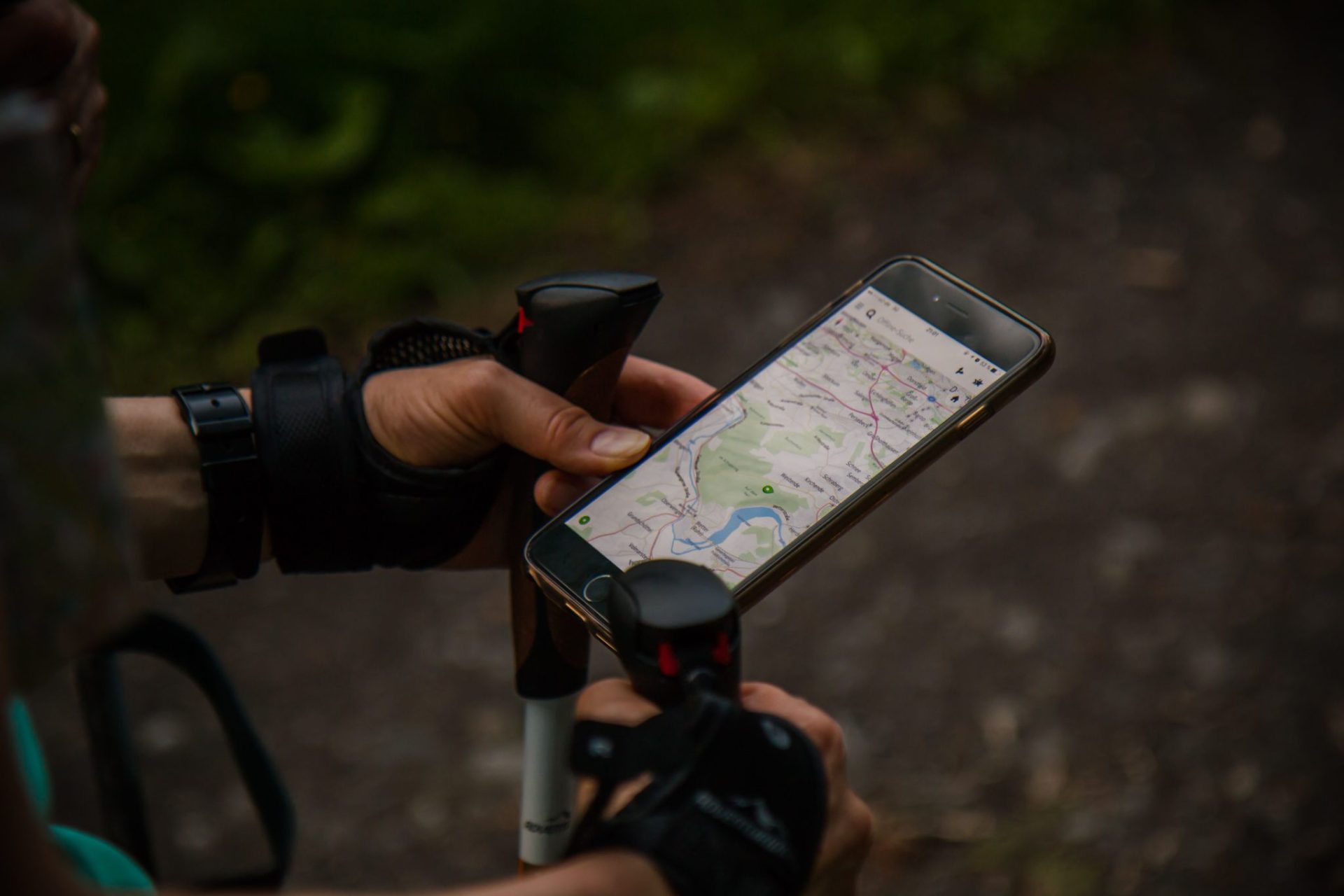
We use our phones. I download maps and we always have GPS available, even when there’s no cell service.
2. Sun Protection
Sun protection may be different for different hikers’ needs, but in general, this includes sunscreen, a sun hat, sunglasses, and for those who use baby carriers, a sunshade for the baby carrier. We pack sunhats for each of us for almost every hike as a hot trail can be miserable without shade. But while working on my 10 Essentials pack, I added some sample packets of sunscreen. They don’t weigh much, and if we need them, they’ll last us a for a day or two.
Sun protection is kind of a given anytime you’re hiking, but for your 10 Essentials kit, think of being stuck in the sun for hours, without any shade. This can happen on the trail if someone gets hurt and others have to hike out for help. A little sun protection can go a long way toward making your situation more bearable.
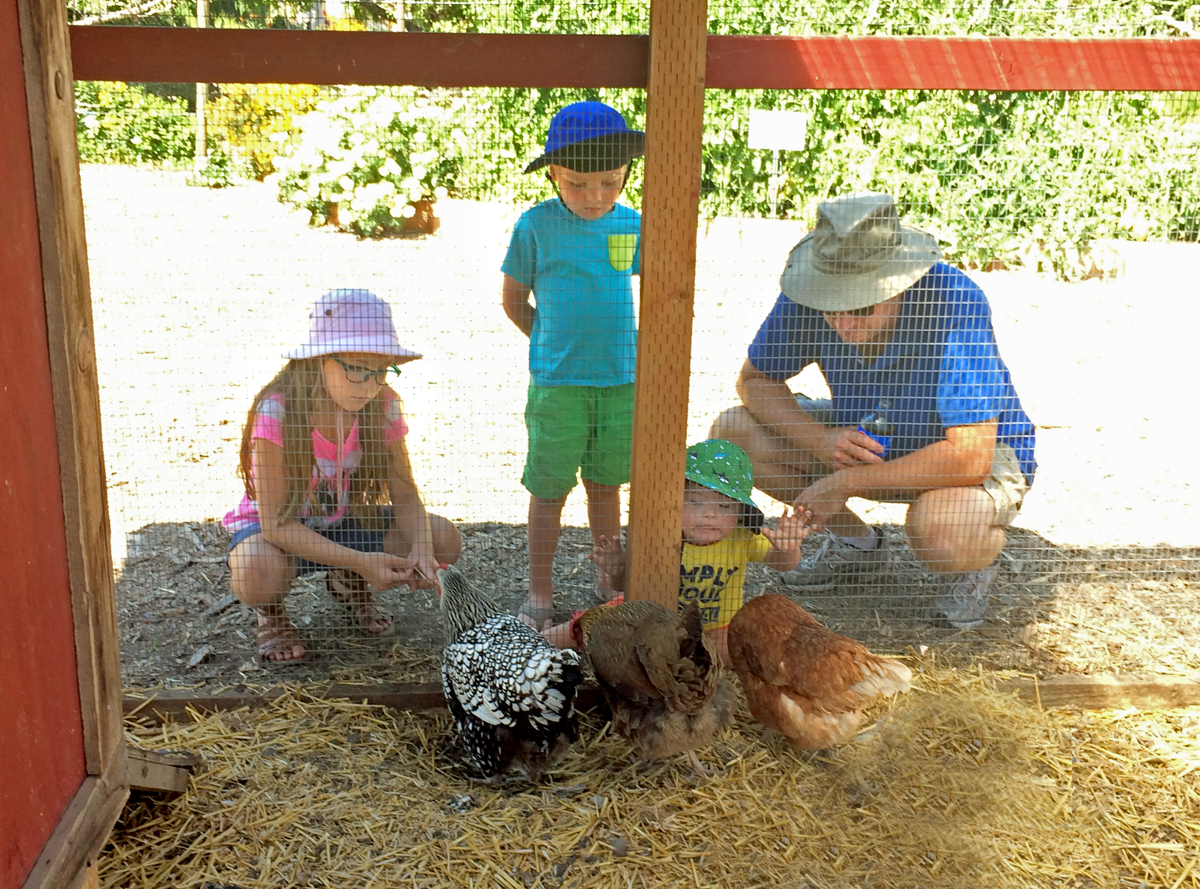
Sunhats are an easy way to shade your face, and in our family, everyone has one.
3. Insulation
Officially, the recommendation is for jacket, hat, gloves, rain shell, and thermal underwear. If you’re caught outside overnight, these items would all make for a more comfortable night.
For us, that is a lot to carry for 8 people, especially when some of those people can’t carry their own load. REI recommends “beyond the minimum expectation”. So, for us, this means packing a jacket or hoodie for everyone and also having a mylar rescue blanket for every person. The jackets are practical on the trail, and the rescue blankets (which are tiny and weigh almost nothing) give us some promise of warmth if we have to spend a cold night outside.
4. Illumination
Any kind of light is preferable to none, so pack a flashlight. We chose to go with headlamps. So far, our 10 Essentials pack only includes two headlamps, one for each adult. But eventually, I’d like enough for everyone to have one. Headlamps are inexpensive, lightweight, and now that most are LED, their batteries last for years. We’ve used them for camping for a while now, but I bought new ones for our 10 Essentials kit.
In an emergency situation, a headlamp will allow you to safely leave the trail to find firewood (or a bathroom). You can tend a wounded hiker in the dark with both of your hands free.

We use headlamps for camping and caving, but now we carry them in our 10 Essentials pack as well.
5. First-Aid Supplies
I will admit that after I read about the Eagle Creek fire and its heroine, Emily, I didn’t exactly leap to making our 10 Essentials kit. That actually came with our own brush with calamity.
We’d hiked into Henline Falls, near Salem. My husband is on blood thinners for a clotting disorder. The kids were throwing rocks into the splash pool below the falls when a rock slipped and went sideways. It caught my husband in the face. He bled profusely, as head cuts do, but thanks to his medication, it didn’t stop. I realized our nearest first-aid kit was in our van, a mile down the trail. Thankfully the bleeding did eventually slow, and we hiked out without further incident. But the very next day, I gathered all of our first-aid kits and emptied them. I cleaned out old ointments and empty Band-Aid packages, then refilled them with trail-appropriate bandages and basics. And most of all, I made sure we’d always have a first-aid kit with us when we hike.
You can make your own custom kit or get started with a premade kit. They don’t have to be complicated: I met a professional hiker who only carries medical tape. I prefer to have a bit more, like antibiotic ointment and Mickey Mouse Band-Aids! I’m not performing surgery on the trail, so I don’t feel the need to carry a huge kit, but a few basics can help you make it back to civilization in case something does happen.

These kits live in our car. In our backpack that we now carry on every hiking trip, we have a ziptop bag with first-aid supplies. First-aid is an important part of your 10 essentials for short day hikes.
6. Fire
If you’re stuck for any amount of time in the woods, you’ll need a way to start a fire. Fire brings protection, warmth, and a certain measure of comfort. It can purify drinking water or provide a hot meal. (Of course, always use fire safely and obey all fire restrictions. Build a fire ring and make sure it’s out out before you leave.) I debated between waterproof matches and a fire starter for our own 10 Essentials kit. Matches are lightweight and cheap. They’re also easy to use, we all know how to light a match. Fire starters aren’t expensive, nor are they heavy. They have more of a learning curve (anyone ever watch Survivor?!) but they’re limitless. You can use them over and over forever.
In the end, I chose matches. After all, how many times will I need to start a fire on the trail? Hopefully never. A simple pack of waterproof matches in a plastic case should be sufficient. We now carry the UCO Stormproof Match Kit.

Photo by Camille, Oregon Outdoor Family
While researching for this post, I came across a great review article in Gear Junkie comparing the different types of fire starting methods. They recommend always having a backup fire starting method in case the first doesn’t work. This resonates with me, and I am adding a simple Bic lighter to our pack.
7. Repair Kit & Tools
Be sure to always carry a wrench, screwdriver, and hammer when you’re hiking.
Kidding. But a multi-purpose knife like a Leatherman or a Swiss Army knife can be a game changer if you’re stuck in the woods. By the way, did you know that the Leatherman tool was created by an Oregonian? It’s true! Tim Leatherman was an engineering student at Oregon State University when a bad hotel stay gave him the inspiration for a multi-use tool.
I chose to go with Leatherman for two reasons. One, the sturdy pliers give Leatherman tools a big advantage over other types of multi-use knives. Two, durability. I’ve owned my Leatherman for 25 years and it still works just as well as it did when it was new. I would suggest that this isn’t the place to buy a cheap knockoff, but I have to admit that one such knife did serve Aron Ralston well when he was trapped in a canyon in Utah. His story is immortalized in the movie 127 Hours. (Spoiler alert: he saved himself by using a dull knife after getting trapped while hiking alone.) I guess my only real advice is: buy one. Buy any multitool. Because anything is better than nothing.
8. Nutrition
We always carry snacks, that’s just a given with kids. But what about actually spending a night outside? Um…I’ve never done that, have you? Unplanned, I mean. The way the Eagle Creek hikers did during the fire. Our granola bars and applesauce pouches wouldn’t go very far. Hiking experts recommend packing an entire day’s worth of food for every member in your party. That’s smart, undoubtedly. Is it practical? For a short day hike, that’s your call.
As for us, we’ve decided to pack ONE meal for our entire group. After reading a gazillion reviews on freeze-dried hiking food, I chose a couple of meals from Mountain House. One meal contains 2 servings. They run $5-8 for a single pouch. Costco also carries them in bulk boxes. While we do sometimes hike in remote areas, like Horse Rock Ridge or Crack in the Ground, we’re never that far from help. I don’t expect to spend more than a few hours or perhaps one night before being rescued. But if you hike in very remote locations, or hike alone, I definitely recommend packing more food just in case.
These meals can be made with cold water, but will taste better with hot water, so we are also adding a stainless-steel cup to our 10 essentials for short day hikes kit.
9. Hydration
Even more important than food is water. You must have a way to produce clean water. Giardia is alive and well in all of Oregon’s waterways. Other organisms thrive, too, that can cause illness. Never drink untreated water unless you’re literally going to die without it! Carrying a filtration device or iodine tablets are a simple method of sanitizing water. We choose to carry both.
There are a ton of filtration devices on the market. Choose what you like best. There are filter pumps, filtering water bottles, pens, and more. We decided to use a filtration pen, specifically the Lifestraw. Technically, you should have one for every person. But we only have two. Partly for weight, partly for cost, and partly because drinking untreated water is worse than sharing a filter with my kids. The benefit to a Lifestraw is that they’re lightweight and easy to use. They’re also fairly instantaneous.
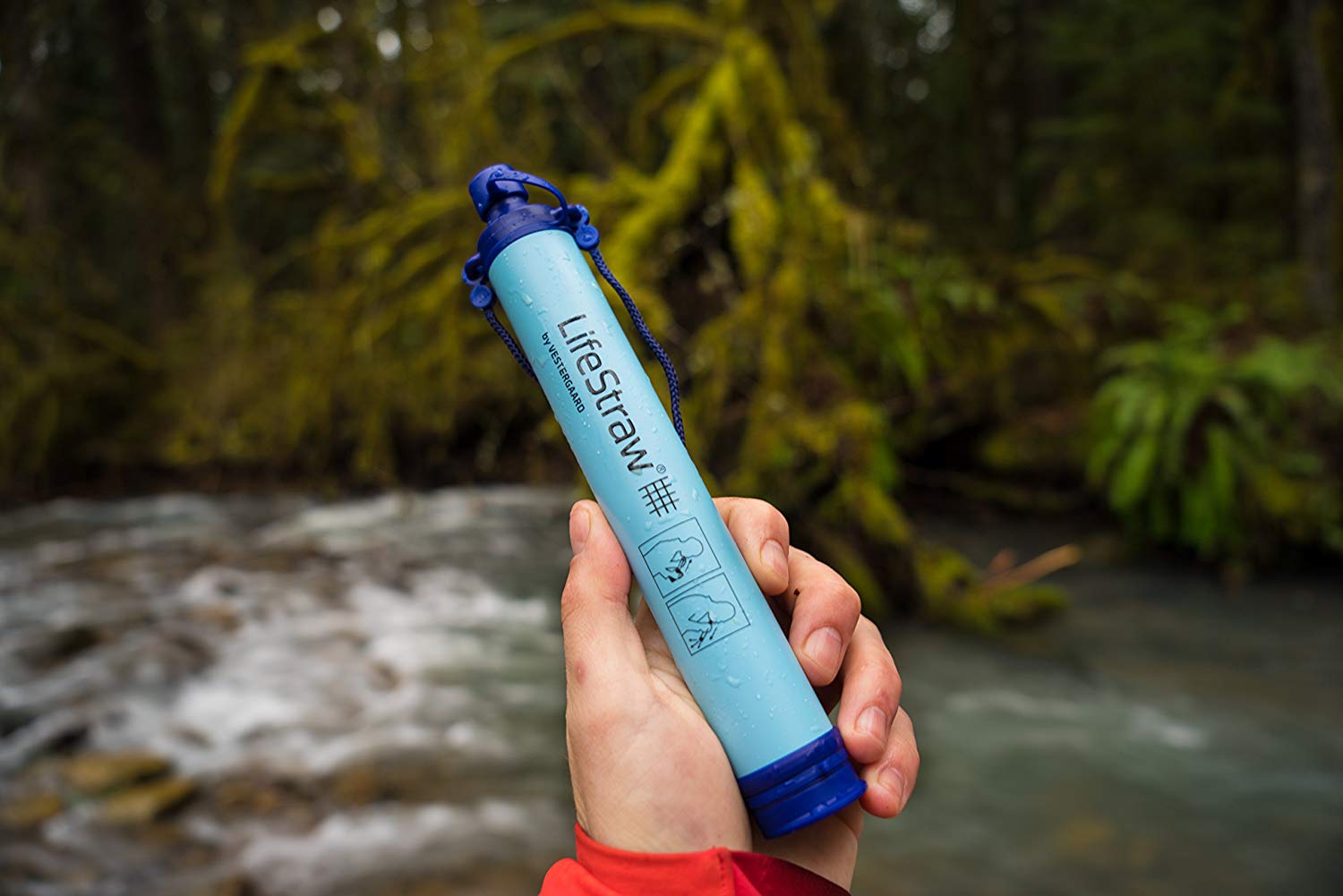
Photo by Lifestraw
We also carry water purification tablets. You can buy these almost anywhere; even most big box stores have them. These are our backup plan if we ever get stranded on a trail. Fill a water bottle, drop in a tablet, and wait 35 minutes. The water won’t be clear or clean, but it will be sanitary. A second tablet in the kit neutralizes the iodine flavor. Bonus: tablets take up almost no space in your pack.
We also pack a stainless-steel water cup by GSI Outdoors. You can use this 20-ounce cup over the fire to boil water for your freeze-dried food or to purify drinking water. Boil vigorously for 5 minutes to purify water.
10. Shelter
The tenth item for the 10 Essentials for short day hikes is shelter. Should you carry a tent everywhere you go? You certainly can, but generally, that’s more than you truly need. What you need is a way to stay warm(ish) and dry(ish). Many experts recommend carrying mylar foil blankets. They’re super lightweight and cheap. I bought foil blankets for every member of our family. You can also buy mylar foil sleeping bags and tents. They weigh almost nothing and they’re also waterproof. Seems like a small price to pay for something that could make a long night more bearable.
If you choose to buy some foil blankets, buy the biggest size you can find. I found some that are larger than most and should provide space to roll up in it a bit, or to have a child inside with me.
The 10 Essentials Pack
Last, but never least, you’ll need something to carry everything. Any backpack will do. In our experience, string backpacks are pretty uncomfortable after a while, so I don’t recommend these for hiking. School backpacks work just fine, but we found that our favorite hiking backpacks are those that have a chest strap.
We have several backpacks. Our favorites are from REI and are specifically for hiking. They have convenient pockets, including one with a hook for hydration bladders. We also have an inexpensive lightweight packable backpack from Amazon. At only $16, I was curious if it could actually hold up to hiking. You don’t have to spend a ton of money or buy a fancy pack for it to work.
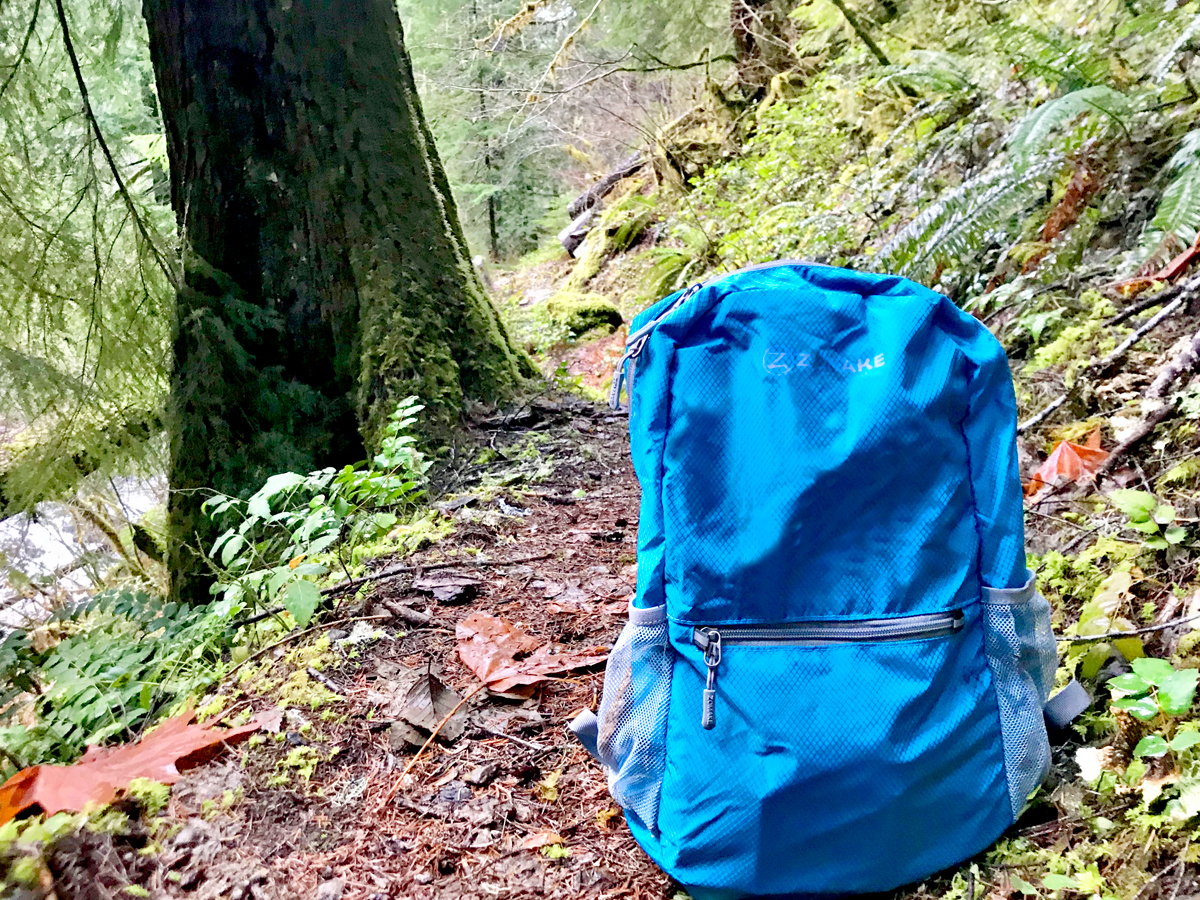
My $16 backpack from Amazon. It doesn’t have a hydration bladder hook inside, but I rigged it up for one hiking trip and it worked fine.
Overwhelmed?
If even our pared-down list seems daunting (or expensive), check out this slimmer list from Mountaineer Sara Ramsay.
- Navigation – map and phone
- Illumination – Headlamp
- Sun Protection – a small tube of sunscreen
- First Aid – small first aid kit
- Knife & Repair Kit – zip ties and duct tape
- Fire – Lighter
- Shelter – trash bag
- Nutrition – extra granola bars
- Hydration – purification tablets
- Extra clothing – extra fleece or jacket
Do it!
I implore you to create your own pack of the 10 Essentials for short day hikes. Our own experience demonstrates that the unexpected can happen, like someone getting hurt. Weather, fires, and car trouble can intervene. In fact, just today, as I’m finishing this article, I heard on the news about a couple who left for a Valentine’s Day hike was just rescued after eight days in the woods. They went on a short hike and did not take food, water, or their cell phones. Clearly, they didn’t expect to be gone long. Life has a way of changing our plans. The couple was rescued, thankfully, and they’ll be fine.
Pin this post! 10 essentials for short day hikes
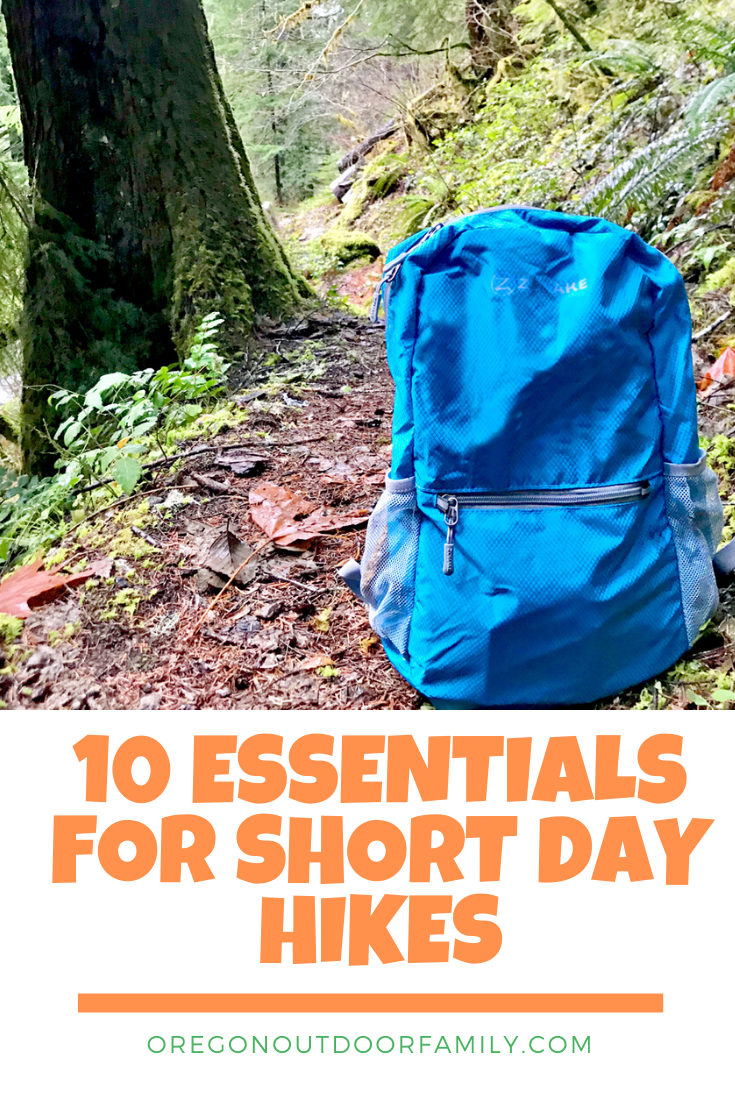

6 comments
Great tips! The fire sounds scary!
I’m sure it was terrifying. I can’t imagine being in that position with my kids.
These 10 essentials are brilliant and don’t sound too difficult to carry on a hike. Thanks for the list!
I should weigh how much everything is all together. It’s not very much! And I have plenty of room for other things. Makes me wonder why I didn’t do it a long time ago.
I’ve had a similar experience with needing a first aid kit on a short hike…and didn’t have one on me. We have a pretty robust first aid kit in the car and we weren’t that far from the parking lot. Hiked to waterfall and my husband fell right onto the sharp rocks in the pond and cut his leg wide open. Took us (3 adults and 2 little kids) an hour to get back to the car. I will never hike without a first aid kit ever again, even a short hike.
Thank you for sharing your experience! It’s so scary to think “what if…” especially when you have kids.